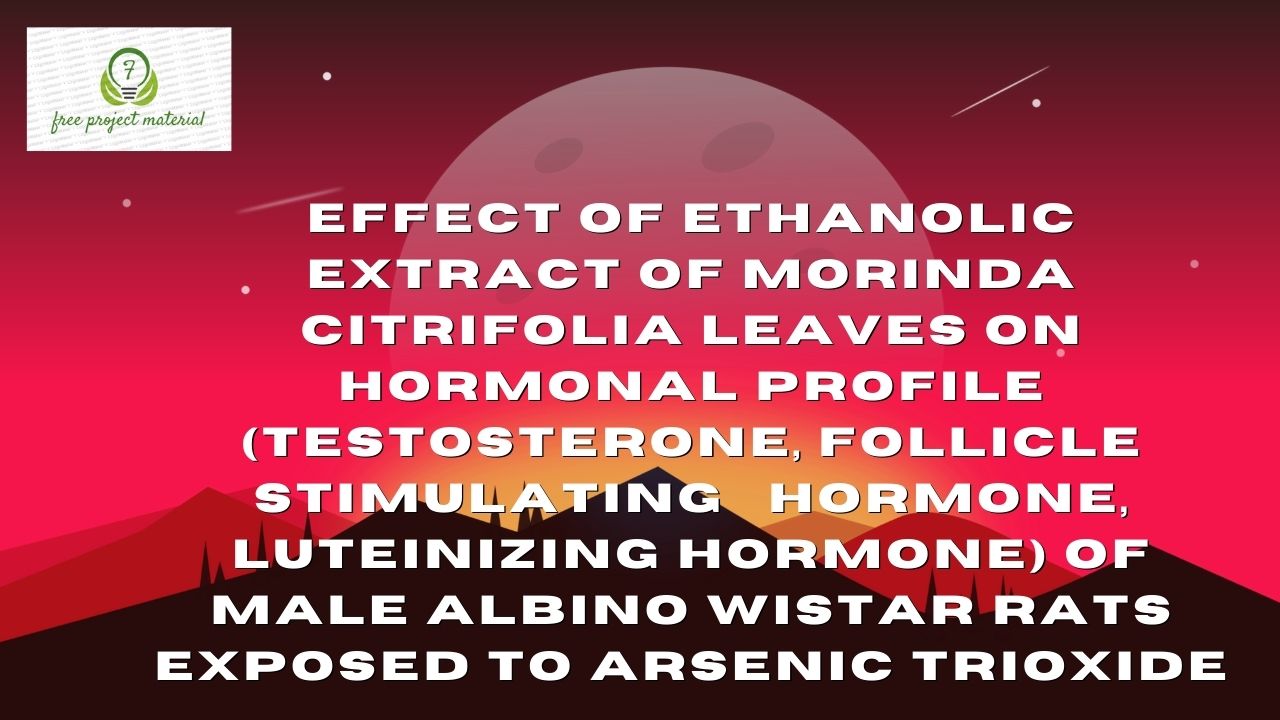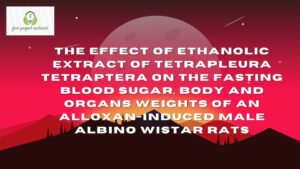ABSTRACT
The aim of this study was to examine the effect of ethanolic extract of Morinda citrifolia leaves on male reproductive hormones (Testosterone, LH, FSH) of male albino wistar rats exposed to arsenic trioxide. 20 male albino rats were randomly assigned five (5) groups of four (4) rats each. Group 1 (the normal control) was fed with normal rat chow and distilled water for 14 days, Group 2 (the negative control) was orally administered 25% (3.65mg/kg) of the LD50 (14.6mg) of arsenic trioxide, normal rat chow and distilled water for 14 days, Group 3,4 & 5 (experimental groups) were given 100 mg/kg body weight, 200 mg/kg body weight and 300 mg/kg body weight of the ethanolic leaves extract of Morinda citrifolia with concomitant exposure to arsenic trioxide, normal rat chow and distilled water for another 14 days. The result of the study reveals that the administration of arsenic trioxide significantly decreased the LH, FSH and Testosterone in all the treatment groups when compared to the normal control. On administration of ethanolic leaves extract of Morinda citrifolia, there was significant increase in the male reproductive hormones thereby reversing the effect of the arsenic trioxide. Therefore, it is recommended that the plant extract could be utilized in the management of male infertility issues and its consumption is recommended as well.
Keywords: Morinda citrifolia, Arsenic trioxide, Hormonal profile, Therapeutic.
TABLE OF CONTENT
TITLE PAGE – – – – – – – – i
CERTIFICATION – – – – – – – ii
DEDICATION – – – – – – – – iii
ACKNOWLEDGEMENT – – – – – – iv
ABSTRACT – – – – – – – – v
TABLE OF CONTENTS – – – – – – vi
LIST OF TABLES – – – – – – – x
LIST OF FIGURES – – – – – – – xi
LIST OF PLATES – – – – – – – – xii
CHAPTER ONE: INTRODUCTION
1.1 Background of the Study – – – – – – 1
1.2 Aim and Objectives of the Study – – – – – 5
1.2.1 Aim of the study – – – – – – – 5
1.2.2 Objectives of the Study – – – – – – 5
1.3 Significance of the Study – – – – – – 6
1.4 Scope and Limitation of the Study – – – 7
1.5 Definition of Terms – – – – – – – 7
1.6 Abbreviations – – – – – – – 9
CHAPTER TWO: LITERATURE REVIEW
2.1 Botanical Classification of Morinda citrifolia – – – 11
2.2 Description and Distribution of Morinda citrifolia – – 12
2.3 Nutritional Value of Morinda citrifolia – – – – 15
2.4 Ethnomedicinal Uses of Morinda citrifolia – – – 16
2.5 Culinary Uses of Morinda citrifolia – – – – 18
2.6 Phytochemistry of Morinda citrifolia – – – – 20
2.7 Pharmacological Activities of Morinda citrifolia – – 21
2.8 Heavy Metals and their Toxicity – – – – – 25
2.8.1 Arsenic Trioxide – – – – – – – 28
2.9 Medicinal Use of Arsenic Trioxide – – – – 29
2.10 Toxicity of Arsenic trioxide – – – – – 30
2.11 Absorption and Distribution of Arsenic in the Body – – 31
2.12 Mechanism of Arsenic Toxicity – – – – – 32
2.13 Clinical Implications of Arsenic Toxicity – – – 34
2.14 Treatment of Arsenic Toxicity – – – – – 36
2.15 Hormonal Profile – – – – – – – 37
2.15.1 Testosterone – – – – – – – 39
2.15.2 Follicle-stimulating Hormone – – – – – 41
2.15.3 Luteinizing Hormone – – – – – – 43
2.16 Review of Related Works – – – – – – 45
CHAPTER THREE: METHODOLOGY
3.1 Materials and Reagents – – – – – – 47
3.2 Collection and Preparation of Leaf Sample – – – 49
3.2.1 Collection of Leaf Sample – – – – – 49
3.2.2 Preparation of Leaf Sample – – – – – 49
3.3 Preparation of Heavy Metal – – – – – 50
3.4 Experimental Design, Grouping and Treatment of Animals – 51
3.5 Collection of Blood Sample – – – – – 52
3.6 Analysis of Hormones – – – – – – 53
3.6.1 Analysis of Testosterone – – – – – – 53
3.6.2 Analysis of Follicle Stimulating Hormone – – – 54
3.6.3 Analysis of Luteinizing Hormone – – – – 54
3.7 Statistical Analysis – – – – – – – 55
CHAPTER FOUR: RESULT AND DISCUSSION
4.1 Morphology and physiology of the rats – – – – 56
4.2 Results – – – – – – – – – 57
4.3 Discussion – – – – – – – – 59
CHAPTER FIVE: CONCLUSION AND RECOMMENDATIONS
5.1 Conclusion – – – – – – – – 66
5.2 Recommendations – – – – – – – 66
References
LIST OF TABLES
Table I: Result of Hormonal profile – – – – – – – 57
LIST OF FIGURES
Figure I: Structure of Testosterone – – – – – – – 41
Figure II: Structure of Follicle Stimulating Hormone – – – – 43
Figure III: Structure of Luteinizing Hormone – – – – – – 45
LIST OF PLATES
Plate 1: Morinda citrifolia plant – – – – – – – 12
CHAPTER ONE: INTRODUCTION
1.1 Background of the Study
All through history, mankind has depended on plants for their survival. Not only does it serve as an essential nourishment source and as building material and weapons due to its basic properties but moreover as a source of medicine. Plant utilization as pharmaceutical goes back to early man. Fossils record date human utilize of plants as medications at slightest to the center paleolithic age. Confirmations of this early affiliation have been found within the grave of a Neanderthal man buried 60,000 a long time prior (Sumner, 2000). Dust examination demonstrated that the various plants buried with the carcass was all of therapeutic esteem. The earliest known medical record may be a 4000 years old Sumerian clay tablet that recorded plant cures for different ailments. By the time of the antiquated Egyptian civilization, an extraordinary riches of data as of now existed on medicinal plants.
Among the numerous cures endorsed was Mandrake for torment alleviation, and garlic for the treatment of heart and circulatory disorders. This data, beside hundreds of other cures, was protected within the papyrus around 3500 a long time back. Old China is additionally a source of data approximately the early therapeutic employments of plants (Xiao, 1988). Medicinal plants are plants which, in one or more of its organs, contains substance that can be utilized for restorative purposes or which are antecedents for the union of valuable drugs. This depiction makes it conceivable to recognize between restorative plants whose helpful properties and constituents have been set up logically, and plants that are respected as restorative but which have not however been subjected to an exhaustive logical think about. Conventional framework of pharmaceutical proceeds to be broadly polished on numerous accounts. Population rises, insufficient supply of drugs, restrictive fetched of medicines, side effects of several allopathic drugs and improvement of resistance to right now utilized drugs for infectious diseases have driven to expand accentuation on the utilize of plant materials as a source of medicine for a wide assortment of human affliction (Joy et al., 2001).
Medicinal plants possess a wide variety of biological properties and are considered as rich sources of ingredients which can be used in traditional medicines, cosmetics, food industry and in drug development either pharmacopoeial, non-pharmacopoeial or synthetic drugs. These plants play a vital role in the development of human culture around the world and are key sources of nutrition and as such recommended for its therapeutic values. Examples of medicinal plants are Indigoferatinctoria, also known as true indigo, is a species of plant from the bean family that was one of the original sources of indigo dye. True indigo is used in treatment of fever, rheumatoid arthritis, gout, liver and spleen disorder etc. Its leaf promotes hair growth. Another medicinal plant is Silymarin, which possess various pharmacological properties like antioxidant, hepatoprotective, anti-inflammmatory, anti-cancer and cardioprotective activities which helps in the treatment of cirrhosis, jaundice, hepatitis and gall bladder disorder (Saller et al., 2001).
Nigella sativa (also known as black cumin, black caraway, nigella, kalonji) is a medicinal plant which belongs to the family Ranunculaceae which possess wide spectrum of activities viz as diuretic, antihypertensive, anticancer etc. Nigella is beneficial in protection against cell damage and inflammation, improved blood sugar control, a stronger immune system and a healthier heart and brain (Hannan et al., 2021). Ashwagandha (also known as winter cherry, Indian ginseng or withania somnifera) is an evergreen shrub from the night shade family. It is exceedingly respected in home grown medication, with numerous ashwagandha supplements, teas and root powders broadly available. This adaptogen is ideal to help the physique overcome stress through directing the brain hypothalamic pituitary adrenal (HPA) pivot. The HPA pivot produces and discharges numerous hormones-counting cortisol that starts the body reaction to stress (Malik et al., 2009).
Lastly, Morinda citrifolia also known as Noni, is a fruit bearing tree in the coffee family, Rubiaceae. All parts of the plant possess medicinal properties and has attained significant economic importance worldwide in recent years because, a variety of health and cosmetic products are made from its leaves and fruits. It has traditionally been used in the treatment of cold, flu, diabetes, anxiety and high blood pressure. Laboratory studies on human cell lines and animals show that noni extracts have anticancer effects both when used alone and with chemotherapy drugs (Singh and Rai, 2007).
1.2 Aim and Objectives of the Study
1.2.1 Aim of the Study
The aim of this study was to examine the effect of ethanolic extract of Morinda citrifolia Leaves on Hormonal profile (Testosterone, Follicle Stimulating Hormone, Luteinizing Hormone) of male albino wistar rats exposed to an inorganic arsenic compound, Arsenic trioxide.
1.2.2 Objectives of the Study
i) To examine the effect of ethanol Leaf extract of Morinda citrifolia on Testosterone level of arsenic trioxide exposed albino wistar rats.
ii) To examine the effect of ethanol Leaf extract of Morinda citrifolia on Follicle Stimulating Hormone level of arsenic trioxide exposed albino wistar rats.
iii) To examine the effect of ethanol Leaf extract of Morinda citrifolia on Luteinizing Hormone level of arsenic trioxide exposed albino wistar rats.
iv) To examine the effect of arsenic trioxide on hormone levels of exposed male albino wistar rats.
v) To make valuable recommendations based on the analytical results obtained during this research work.
1.3 Significance of the Study
The result obtained from this research work will be useful to medical doctors, pharmacist, and herbalist etc in confirming believes obtained from folklore medicine on the effect of Morinda citrifolia on arsenic trioxide (heavy metal) poisoning (arsenicosis). The result will also be useful to other researchers in providing new insights and focus on the effect of ethanolic extract of Morinda citrifolia on the Hormone levels (Testosterone, Follicle Stimulating Hormone, Luteinizing Hormone) of male albino wistar rats exposed to arsenic trioxide. Morinda citrifolia possess a large range of therapeutic claims, including antihelminthic, antiviral, antitumor, analgesic, hypotensive, antibacterial, antifungal and immune enhancing effects. The plant (noni) also serves as industrial products in food industry mainly beverages (juice drinks), powders (from dried fruits), oil (from seed), and leaf powders. Moreover, the analytical results presented in this study will convey valuable information for future research that will explore various medicinal benefits of Morinda citrifolia such as improved liver function, joint health and gum health, free flow of oxygen in the body, increased physical endurance ,maintenance of bone health and blood pressure, inhibition of protein glycation and increased immune activity as it has proven beneficial in conditions like gastritis, skin diseases, respiratory infections, venereal diseases and fever.
1.4 Scope and Limitation of the Study
The scope of this study covers the effect of ethanolic extract of Morinda citrifolia Leaves on Hormonal profile (Testosterone, Follicle Stimulating Hormone, Luteinizing Hormone) of male albino wistar rats exposed to arsenic trioxide. However, the limitation of this study includes lack of experimental equipment, financial constraint and time frame.
1.5 Definition of terms
Heavy metal: are metallic elements that have a relatively high density compared to water.
Arsenic trioxide: is an inorganic compound and medication used to treat acute promyelocytic leukemia that has a certain chromosome abnormality or a fusion gene called progressive multi-focal leukoencephalopathy (PML).
Ethanolic extract: is a process used in fine liquor distillation to filter out alcohol content from extracted material.
Extract: is a preparation containing the active ingredient of a substance in concentrated form.
Morinda citrifolia Leaf: is a medicinal food (Ulam) used in traditional malay medicine to prevent chronic diseases, may have the potential to be formulated into a functional anti-atherosclerotic agent.
Hormones: are chemical substance that act like messenger molecules in the body. After being made in one part of the body, they travel to other parts of the body where they help control how cell and organs do their work, such as insulin is a hormone that’s made by the beta cell in the pancreas.
Testosterone: is the key male sex hormone that regulates fertility, muscle mass, fat distribution and red blood cells production.
Follicle Stimulating Hormone: is a gonadotropin, a glycoprotein polypeptide hormone synthesized and secreted by the gonadotropic cells of the anterior pituitary gland and regulates the development, growth, purbertal maturation and reproductive processes of the body.
Luteinizing Hormone: is a hormone secreted by the anterior pituitary gland that stimulates ovulation in females and the synthesis of androgen in males.
1.6 Abbreviations
FSH: Follicle Stimulating Hormone
LH: Luteinizing Hormone
GnRH: Gonadotropin-Releasing Hormone
ICSH: Interstitial Cell Stimulating Hormone
MMA: Monomethylarsonic acid
DMA: Dimethylarsinic acid
SAM: S-adenosylmethionine
GSH: Glutathione
AS2O3: Arsenic trioxide
APL: Acute promyelocytic leukemia
DNA: Deoxyribonucleic acid
RNA: Ribonucleic acid
ROS: Reactive Oxygen Species
HPA: Hypothalamic Pituitary Adrenal
DRIs: Dietary Reference Intakes
BK: Bradykinin.



